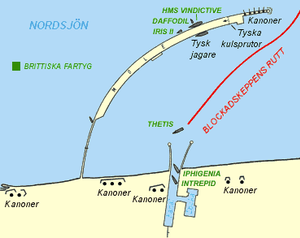Zeebrugge raid
| Zeebrugge Raid | |||||||
|---|---|---|---|---|---|---|---|
| Part of the First World War | |||||||
 Diagram of Zeebrugge harbour after the raid |
|||||||
|
|||||||
| Belligerents | |||||||
|
|
|
||||||
| Commanders and leaders | |||||||
|
|
|
||||||
| Strength | |||||||
| 75 ships 1,700 men |
unknown | ||||||
| Casualties and losses | |||||||
| 227 dead 356 wounded Destroyer HMS North Star sunk |
8 dead 16 wounded |
||||||
The Zeebrugge Raid (French: Raid sur Zeebruges; 23 April 1918), was an attempt by the Royal Navy to block the Belgian port of Bruges-Zeebrugge. The British intended to sink obsolete ships in the canal entrance, to prevent German vessels from leaving port. The port was used by the Imperial German Navy as a base for U-boats and light shipping, which were a threat to Allied shipping, especially in the English Channel. Several attempts to close the Flanders ports by bombardment failed and Operation Hush, a plan to advance up the coast in 1917, proved abortive. As shipping losses to U-boats increased, finding a way to close the ports became urgent and a raid was considered.
The first attempt on Zeebrugge was made on 2 April 1918 but cancelled at the last moment, after the wind direction changed and made it impossible to lay a smoke-screen. Another attempt was made on 23 April with a concurrent attack on Ostend. Two of three blockships were scuttled in the narrowest part of the Bruges Canal and one of two submarines rammed the viaduct, which linked the shore and the mole, to isolate the German garrison. The blockships were sunk in the wrong place and after a few days, the canal was open to submarines at high tide. British casualties were 583 men and German losses were 24 men; the raid was publicised by the British around the world as a great success and many medals were awarded.
At the end of 1916 a combined operation against Borkum, Ostend and Zeebrugge had been considered by Admiral Lewis Bayly, senior officer on the coast of Ireland. The plan was rejected due to the difficulty of supplying a landing force and the vulnerability of such a force to a land counter-attack; subsequent proposals were rejected for the same reasons. A bombardment of the Zeebrugge lock-gates under cover of a smoke-screen, was studied by Vice Admiral Sir Reginald Bacon, commander of the Dover Patrol and the Admiralty in late 1915 but was also rejected, because the risks were considered excessive. In 1916, Commodore Reginald Tyrwhitt proposed an attack to block Zeebrugge which was rejected and led him to propose a more ambitious operation to capture the mole and the town, as a prelude to advancing on Antwerp. Bacon was asked to give his opinion and rejected the plan, as did the Admiralty.
...
Wikipedia
